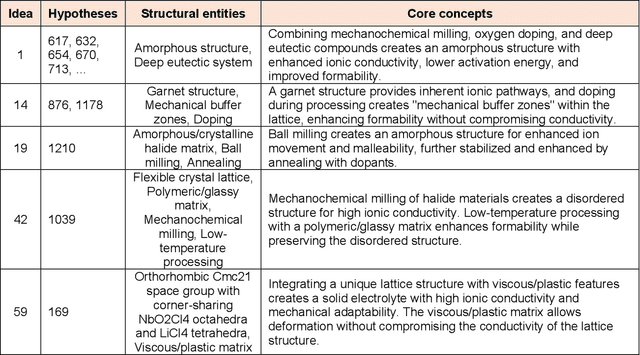So Yeon Kim
Collaborative AI Enhances Image Understanding in Materials Science
Mar 17, 2025Abstract:The Copilot for Real-world Experimental Scientist (CRESt) system empowers researchers to control autonomous laboratories through conversational AI, providing a seamless interface for managing complex experimental workflows. We have enhanced CRESt by integrating a multi-agent collaboration mechanism that utilizes the complementary strengths of the ChatGPT and Gemini models for precise image analysis in materials science. This innovative approach significantly improves the accuracy of experimental outcomes by fostering structured debates between the AI models, which enhances decision-making processes in materials phase analysis. Additionally, to evaluate the generalizability of this approach, we tested it on a quantitative task of counting particles. Here, the collaboration between the AI models also led to improved results, demonstrating the versatility and robustness of this method. By harnessing this dual-AI framework, this approach stands as a pioneering method for enhancing experimental accuracy and efficiency in materials research, with applications extending beyond CRESt to broader scientific experimentation and analysis.
Beyond designer's knowledge: Generating materials design hypotheses via large language models
Sep 10, 2024



Abstract:Materials design often relies on human-generated hypotheses, a process inherently limited by cognitive constraints such as knowledge gaps and limited ability to integrate and extract knowledge implications, particularly when multidisciplinary expertise is required. This work demonstrates that large language models (LLMs), coupled with prompt engineering, can effectively generate non-trivial materials hypotheses by integrating scientific principles from diverse sources without explicit design guidance by human experts. These include design ideas for high-entropy alloys with superior cryogenic properties and halide solid electrolytes with enhanced ionic conductivity and formability. These design ideas have been experimentally validated in high-impact publications in 2023 not available in the LLM training data, demonstrating the LLM's ability to generate highly valuable and realizable innovative ideas not established in the literature. Our approach primarily leverages materials system charts encoding processing-structure-property relationships, enabling more effective data integration by condensing key information from numerous papers, and evaluation and categorization of numerous hypotheses for human cognition, both through the LLM. This LLM-driven approach opens the door to new avenues of artificial intelligence-driven materials discovery by accelerating design, democratizing innovation, and expanding capabilities beyond the designer's direct knowledge.
Semi-Supervised Graph Representation Learning with Human-centric Explanation for Predicting Fatty Liver Disease
Mar 05, 2024


Abstract:Addressing the challenge of limited labeled data in clinical settings, particularly in the prediction of fatty liver disease, this study explores the potential of graph representation learning within a semi-supervised learning framework. Leveraging graph neural networks (GNNs), our approach constructs a subject similarity graph to identify risk patterns from health checkup data. The effectiveness of various GNN approaches in this context is demonstrated, even with minimal labeled samples. Central to our methodology is the inclusion of human-centric explanations through explainable GNNs, providing personalized feature importance scores for enhanced interpretability and clinical relevance, thereby underscoring the potential of our approach in advancing healthcare practices with a keen focus on graph representation learning and human-centric explanation.
 Add to Chrome
Add to Chrome Add to Firefox
Add to Firefox Add to Edge
Add to Edge